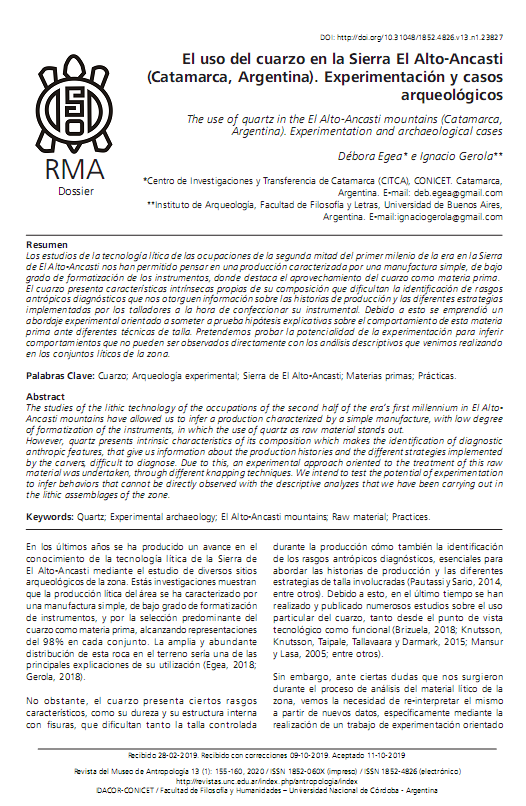The use of quartz in the El Alto-Ancasti mountains (Catamarca, Argentina). Experimentation and archaeological cases
DOI:
https://doi.org/10.31048/1852.4826.v13.n1.23827Keywords:
Quartz, Experimental archaeology, El Alto-Ancasti mountains, Raw material, PracticesAbstract
The studies of the lithic technology of the occupations of the second half of the era’s first millennium in El Alto-Ancasti mountains have allowed us to infer a production characterized by a simple manufacture, with low degree of formatization of the instruments, in which the use of quartz as raw material stands out. However, quartz presents intrinsic characteristics of its composition which makes the identification of diagnostic anthropic features, that give us information about the production histories and the different strategies implemented by the carvers, difficult to diagnose. Due to this, an experimental approach oriented to the treatment of this raw material was undertaken, through different knapping techniques. We intend to test the potential of experimentation to infer behaviors that cannot be directly observed with the descriptive analyses that we have been carrying out in the lithic assemblages of the zone.
Downloads
References
Aschero, C. (1975). Ensayo para una clasificación morfológica de artefactos líticos aplicada a estudios tipológicos comparativos. Informe al CONICET. Manuscrito inédito
Aschero, C. (1983). Ensayo para una clasificación morfológica de artefactos líticos. Apéndice A y B. Cátedra de Ergología y Tecnología. Facultad de Filosofía y Letras. Universidad de Buenos Aires. Manuscrito inédito.
Brizuela, C. (2018). Entre gubias, escoplos y cinceles: Una caracterización funcional de base microscópica, para instrumentos líticos experimentales (Tesis de Licenciatura inédita). Universidad Nacional de Córdoba, Argentina.
De la Peña, P. (2015). A qualitative guide to recognize bipolar knapping for flint and quartz. Lithic Technology, 40(4), 316–331.
Egea, D. (2018). Tecnología lítica en la sierra de El Alto-Ancasti (Catamarca). Aporte desde la experimentación. Revista Del Museo de Antropología, 11(2), 49–58.
Gerola, I. (2018). El hábito de tallar el paisaje verde. Tecnología lítica en el sector septentrional de El Alto–Ancasti (Catamarca), (Tesis de Licenciatura inédita), Universidad de Buenos Aires, Argentina.
Gordillo, I., Zucarelli, V., & Eguia, L. (2017). Las casas del sol naciente, arqueología de la vertiente oriental del Alto-Ancasti. En Ventura, B. N., Ortiz, G., & Cremonte, M. B. (Eds.), Arqueología de la vertiente oriental surandina. Interacción macro-regional, materialidades, economía y ritualidad (pp. 111–134). Buenos Aires: Sociedad Argentina de Antropología.
Knutsson, H., Knutsson, K., Taipale, N., Tallavaara, M., & Darmark, K. (2015). How shattered flakes were used: Micro-wear analysis of quartz flake fragments. Journal of Archaeological Science: Reports,2, 517-531.
Mansur, M. E., & Lasa, A. (2005). Diversidad artefactual vs. Especialización funcional. Análisis del IV componente de Túnel I (Tierra del Fuego, Argentina). Magallania, 33(2), 69-91.
Morgado, A., & Baena, J. (2011). Experimentación, Arqueología experimental y experiencia del pasado en la Arqueología actual. En Morgado, A., Baena, J., García, D. (Eds.), La investigación experimental aplicada a la Arqueología (pp. 21-28). Granada: Universidad de Granada.
Nami, H. (2000). Investigaciones actualísticas y piedra tallada. I) Criterios experimentales para identificar lascas de talla bipolar: Su aplicación en la interpretación de artefactos arqueológicos de los extremos norte y sur de la Patagonia. En Actas del III Congreso Argentino de Americanistas 3 (pp. 229-270). Buenos Aires: Sociedad Argentina de Americanistas.
Pautassi, E., & Sario, G. (2014). La talla de reducción: aproximaciones experimentales para el estudio del cuarzo. ArqueoWeb, 15, 3–17.
Prous, A. P., Alonso, M., Neves de Sousa, G., Pessoa Lima, A., & Amorel, F. (2009). La place et les caractéristiques du débitage sur enclume (« bipolaire ») dans les industries brésiliennes. Paleo, Número esp, 201–220.
Quesada, M. N., Gastaldi, M. R., & Granizo, M. G. (2012). Construcción de periferias y producción de lo local en las cumbres de El Alto-Ancasti. Relaciones de La Sociedad Argentina de Antropología, XXXVII (2), 435–456.
Sánches Yustos, P., Diez Martín, F., Domínguez-Rodrigo, M., & Tarriño Vinagre, A. (2012). Discriminación experimental de los rasgos técnicos en la talla bipolar y a mano alzada en lascas a través de los cuarzos de Naibor Soit (Garganta de Olduvai, Tanzania). MUNIBE (Antropologia-Arkeologia), 63, 5–26.

Downloads
Published
Issue
Section
License
Those authors who have publications with this Journalaccept the following terms:
a. Authors will retain their copyrights and guarantee the journal the right of first publication of their work, which will be simultaneously subject to the Creative Commons Attribution License (Licencia de reconocimiento de Creative Commons) that allows third parties to share the work as long as its author and his first publication in this journal.
b. Authors may adopt other non-exclusive licensing agreements for the distribution of the version of the published work (eg, deposit it in an institutional electronic file or publish it in a monographic volume) provided that the initial publication in this journal is indicated.
c. Authors are allowed and recommended to disseminate their work on the Internet (eg in institutional telematic archives or on their website) before and during the submission process, which can lead to interesting exchanges and increase citations of the published work. (See The Effect of Open Access - El efecto del acceso abierto)











